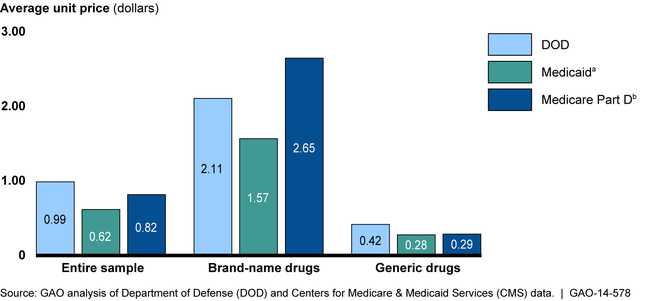Prescription Drugs: Comparison of DOD, Medicaid, and Medicare Part D Retail Reimbursement Prices
Highlights
What GAO Found
GAO found that Medicaid paid the lowest average net prices across a sample of 78 high-utilization and high-expenditure brand-name and generic drugs when compared to prices paid by the Department of Defense (DOD) and Medicare Part D. Specifically, Medicaid's average net price for the entire sample was $0.62 per unit, while Medicare Part D paid an estimated 32 percent more ($0.82 per unit) and DOD paid 60 percent more ($0.99 per unit). Similarly, Medicaid paid the lowest net price for the subset of brand-name drugs in the sample, while DOD paid 34 percent more and Medicare Part D paid an estimated 69 percent more. Medicaid also paid the lowest net price for the subset of generic drugs, while Medicare Part D paid 4 percent more and DOD paid 50 percent more.
Comparison of Average Net Unit Prices for the Sample Drugs, Third Quarter of 2010

aGAO used only federally mandated rebates when calculating Medicaid net prices. If state supplemental rebates had been applied, actual net prices paid by Medicaid would have been lower than the prices shown in the figure. GAO found that the state supplemental rebates, in aggregate, were equivalent to 4 percent of Medicaid expenditures for all drugs in the target quarter.
bThe Medicare Part D net prices are estimates because CMS allows Medicare Part D plan sponsors to use a variety of methods to allocate post-purchase price adjustments to the drug level and thus GAO could not definitively assign rebates to specific drugs.
GAO found that multiple factors affected the net prices paid by each program. Specifically, a key factor for the entire sample and the brand-name subset was the amount of any post-purchase price adjustments, which are the refunds, rebates, or price concessions received by each program from drug manufacturers after drugs have been dispensed to program beneficiaries. These price adjustments ranged from about 15 percent of the gross price for Medicare Part D to about 31 percent for DOD, and nearly 53 percent for Medicaid across the entire sample. The gross prices each program negotiated with pharmacies and the magnitude of beneficiary-paid amounts also contributed to differences in net prices paid by the three programs, but to a lesser degree.
GAO provided a copy of the draft report to DOD and the Department of Health and Human Services (HHS) for comment. DOD stated that it had no comments. HHS provided a technical comment, which was incorporated.
Why GAO Did This Study
In 2011, federal spending for prescription drugs by DOD, Medicaid, and Medicare Part D totaled $71.2 billion—representing about 85 percent of all federal prescription drug expenditures—for about 114.4 million beneficiaries. Each program reimbursed retail pharmacies for outpatient prescriptions filled at these pharmacies by their beneficiaries.
GAO was asked to compare prices paid for prescription drugs across federal programs. This report compares retail reimbursement prices paid by DOD, Medicaid, and Medicare Part D for a sample of prescription drugs and describes factors affecting these prices. Using agency data for the third quarter of 2010 (the most recent data available at the time of GAO's analysis), GAO selected a sample of 50 high-utilization and 50 high-expenditure drugs; after accounting for overlap between the two groups, the final sample contained 78 drugs. GAO calculated average gross unit prices paid to pharmacies by each program by adding total program-paid and beneficiary-paid amounts and dividing by total utilization for each drug, the entire sample, and the subsets of brand-name and generic drugs. GAO calculated net unit prices paid by each program by subtracting all agency-reported beneficiary-paid amounts, rebates, refunds, and other price concessions from the gross unit prices. GAO also interviewed DOD, Medicaid, and Medicare Part D officials and reviewed literature describing factors affecting drug prices.
For more information, contact John Dicken at (202) 512-7114 or dickenj@gao.gov.
